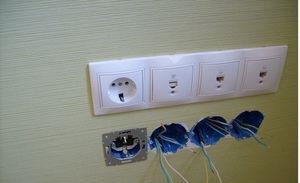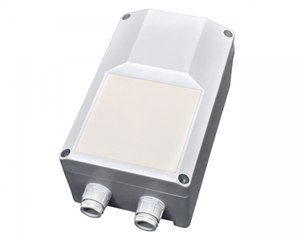How to connect electricity to a house or land: nuances of connection design price
Every landowner at some point begins to think about supplying him with electricity. This work can be done not only during the construction of a country house, but also after putting the house into operation.
Even before you start connecting the network, power should be determined, necessary for a full supply of electricity to a country house, calculate the distance, on which electrical networks must run in relation to the house, as well as learn, whether there is the required network capacity in this area.
List of required documents
If you are determined to bring to the land an electrician, then first of all you need to make an application of the established sample and apply to the organization, which includes maintenance of electrical networks at the location of the site.
There you must issue a permit to connect electricity. In addition to the statement, you will have to prepare and copy the documents, with the signatures of a notary:
- Passport and identification code.
- Documents, establishing ownership of the site and the house.
- Documents for land and house.
- In that case, if the summary is requested by a representative, then a power of attorney is required.
- Electrification project of the house and the plot, which must contain information about all energy consuming devices and their power consumption.
- Building permit. Needed to supply electricity to the site, where there are no buildings.
After preparing the above documents, they must be sent by registered mail. It will be useful to add to them a description of the attached documents.
In that case, if a document does not appear in the package you sent, then the organization is obliged to inform you of this fact no later than 6 days from the date of receipt of documents.
In some cases, you may be asked to send originals of certain documents from the list above., to confirm this information. The documents sent by you will be used by the organization as a basis for drawing up technical conditions, without which it is impossible to supply electricity to the site.
They should reflect the technical characteristics of the introduction of electricity in a private home: This means that a single-phase or three-phase cable will be used to supply electricity to the house.
When you meet all the conditions of this order, you will already have every right to start supplying electricity. An important point is that, that the technical conditions must be met no later than two years from the date of their compilation.
Sometimes this can happen, that due to the peculiarities of the technical conditions of electrical networks it is impossible to supply electricity to the site. A situation is also possible, when the rated load capacity exceeds the rated value of the network.
In such cases, the organization must notify the customer of this fact in writing. It is not possible to appeal the decision.
The cost of connecting electricity to the site
Checking the technical conditions will cost the customer about 456 p. As for the work of connecting electricity to the house, then their cost may be different. The exact amount will be determined by the power connected to the line.
If the power, supplied to the network area exceeds the value 15 kw, then the cost of connecting electricity will be 550 p.
The work can be performed provided, that the goose for supplying electricity to the site is remote from the power line, located in the city, not more 300 meters, and for the countryside - 500 meters.
If you need to connect a new power grid, which involves creating a longer connection, then you need to get permission from local authorities.
What should be in the project of external electrification of a private house
The development of the project of external electrification of a private house can be started only after the completion of technical conditions by the organization, which deals with the maintenance of electrical networks.
When creating the project, the organization relies as a basis on the technical conditions of electrification of land. To perform such work, you need the following:
- Geodetic or situational plan of the site, to which it is necessary to bring electricity. This document should contain information on the location of overhead and cable lines, and in addition communications.
- Electricity metering unit project. It should display information about the nominal value of the input circuit breaker and the current of the installed voltage limiter.
- SIP cable connection project, which is supplied from the line support to the metering unit, transformer substation, located on the site, or underground cable laying.
- Calculation and development of the grounding project.
- In the case of supply of three-phase networks, transformer power calculation procedure, as well as performing calculations of network and switchgear bandwidth together with a distribution cabinet type PR.
- It is mandatory to obtain approval for documentation in the organization, in charge of which is the maintenance of electrical networks at the location of the connected house. In some cases, the consent of local authorities may be required.
How to conduct electricity to the site
It is necessary to keep in mind, that the responsibility for connecting electricity outside the land rests with the organization behind the grid, and the work itself is carried out on the basis of project documentation.
Electricity supply to the site must be performed directly by its owner. The cost of installation work can be different. The cost is calculated in each case individually.
The peculiarity of the supply of electrical networks to the site is, that these works are carried out in several stages. Observance of all technical instructions and approval of the external connection project is a mandatory requirement:
- electricity supply to the site and the house;
- confirmation of operability of devices, which will be used to control electricity consumption;
- electricity supply to the house, installation of sealing meters;
- drawing up a report on the work performed;
- signing a contract for the supply of electricity.
After obtaining approval for the supply of electricity begin directly laying the cable and wiring electricity in a private home.
Connection rules
If it is planned to bring a single-phase line, then it is desirable to use a cable with a minimum cross section 6 mm with copper core or 16 mm with aluminum core. Reliable wire insulation is a must, which should not involve damage and inflections.
The work is based on the supply of two cables to the mains, among which one will act as a phase, and the other zero.
Importantly, so that the cables are at a safe distance from each other: if they are brought to a brick wall, then it must be at least 50 mm, in the case of laying to wooden structures of the building, the cables are placed at a distance 100 mm from each other.
A hole is made in the wall, through which the cable will be entered, must be closed, using non-combustible materials, example, cement or concrete mortar. After that, proceed to the connection of cables to the VRU or energy control device. Here it is necessary to focus directly on the project.
The important point is that, that at removal is brought to electricity of a site concerning support of a power line on distance more 25 meters will need to install additional poles.
It is important to maintain a minimum height from the ground before inserting the cable into the wall, which should be 2,75 meters. Optimal from the cable entry point to the nearest window, the height will be considered not less 1,5 meters.
Consequences of self-supply of electricity to the site
Do not spend in a private home, cottages or plots of electricity, not having a permit to carry out such work.
The same applies to increasing the capacity of the already supplied power line or power consumption monitoring device. Such actions are considered illegal and involve penalties.
If illegally installed line control and distribution devices are detected, then they must be dismantled. The legislation also establishes the disconnection of the site by employees of the organization for electricity from energy consumption.
If the house or plot was connected to electricity without a permit, it is very difficult to give these works a legal character.
The legalization procedure will require much more costs, than in the case of connecting electricity to the site by a licensed organization in accordance with the plan, taking into account the peculiarities of technical conditions.
Alternative electricity
There are situations, when certain circumstances do not allow to connect the site to the power line. In this case, the solution can be autonomous power sources.
Solar collectors can be offered as options, when choosing which you need to pay attention to the power consumed.
If electricity is needed exclusively for household needs, then you can limit the power 6 kw. However, this fact must be taken into account here, that the maximum amount of electricity will be provided only in the period from March to October in sunny weather.
With the onset of cloudy days, the amount of electricity produced will decrease significantly, at the same time at night the site can function only due to the energy reserve in the battery, if it is connected to the solar system.
Deciding to stop the choice on solar panels, the landowner should be prepared for serious costs, which are required to purchase directly the components of the system, as well as to perform work on their installation. In addition, the solar system must be provided with regular maintenance.
Even if you have the necessary experience and know, how to conduct electricity to the site, however, it is undesirable to do this without permission. This can lead to penalties in the future, followed by complete de-energization of your site.
Therefore, for most landowners it is best to use the services of design organizations, in charge of which is the maintenance of electrical networks.



